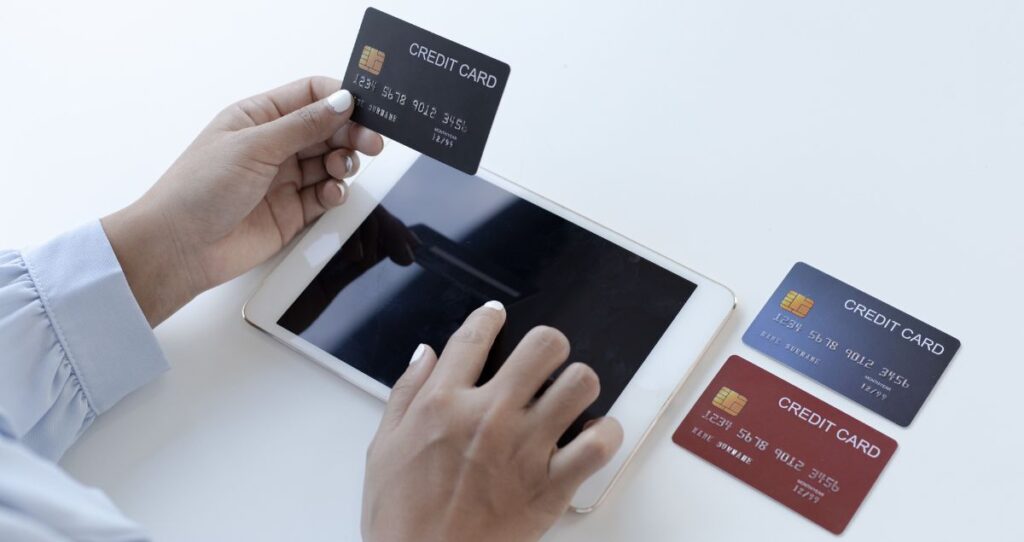Credit cards come in many forms and types. Knowing the different types of credit cards available on the market can help you apply for the right card given your current financial standing and credit history. For example, a person who is new to credit might find it difficult to qualify for 0% APR credit cards. This is because these types of credit cards are usually offered to people with excellent credit histories and good credit scores.
Credit cards are some of the most confusing financial products out there. Not only that there are many types of credit cards, but there are also many variations on credit cards in each category. That is why as a borrower, you should educate yourself before submitting a credit account application. Your credit card application approval rate increases when you apply for the right credit card.
As you go through different types of credit cards, you will understand how each category of credit card works, how you can benefit from it, and whether or not it is the right fit for you. Credit cards work in your favor only if you can maximize the benefits that come with them without violating their terms of service.
How to choose the right credit card?
Knowing different types of credit cards can help you pick the right card. There are a ton of credit card providers and many types of credit cards. A lot of people get confused with the vast number of credit cards and options available. But, the process of choosing the right credit card should be simple and straightforward. It all starts with you, why you need to get a credit card, your current financial standing, and your credit history.
The first step in choosing the right credit card is to know why you need the card in the first place. Do you want to build a credit history, lower your expenses, travel for less money, or cover some of your business expenses? The answer to this question will help you choose the right category of credit cards.
After knowing why you want a credit card, you will then look for a card that matches your needs in that particular category. For example, if you want a business credit card, you will need to only keep your attention on business credit cards. Inside this category, you will have many options to choose from. For example, you might need to consider a business credit card that gives you a higher credit limit because you don’t have enough cash reserves. Or select a card that comes with higher cashback or discounts on some particular business expenses.
More examples of choosing the right credit card
If you travel a lot and want to lower your airfare cost and related expenses, it would make sense to get mile credit cards(which is a subcategory of rewards credit cards). This is because as you fly with a specific airline, you will earn miles that can be converted into cash value or earn you products and services.
But, if you want to lower your grocery bills, save money on gas, and restaurants, you should look into cashback credit cards or points credit cards. With these types of credit cards, you either earn a small percentage of the purchase or earn points. You can then redeem your cashback by depositing it into your bank account, paying the balance on your account, making purchases, etc. Your points can also be redeemed by converting them into cash, buying products, etc.
Those who are new to credit, for example, can’t just qualify for any credit cards. This is because credit cards are a form of revolving credit, and therefore, lenders can deny you credit if you have a thin credit file. Even if you want a cashback credit card, you might need to start with starter credit cards or secured credit cards until you have built enough credit history that will help you qualify for cashback credit cards.
The benefits of knowing different types of credit cards are abundant. So, the more you know about credit cards, the easier it is to choose the right card.
This article will walk you through different types of credit cards and what you should expect to get from them, should you choose to get one.
1. Rewards credit cards
One of the most common types of credit cards is the rewards credit card. These credit cards come in many forms and can sometimes overlap with other types of credit cards. For example, some student credit cards offer rewards similar to those you get from normal rewards credit cards. Just because all these cards offer rewards, it does not mean they are the same.
Student credit cards come with much lower credit limits(usually under $1,000) whereas rewards credit cards come with higher limits. This is why knowing different types of credit cards and the benefits that come with them can better help you choose the best credit card. Many people struggle with choosing the right credit card. However, the best strategy to choose a credit card is to know what you want to do with the card.
For example, if you want to save money on groceries, gas, and restaurants, it would be wise to get a cashback credit card. This is because cashback credit cards offer discounts(usually a percentage of the sale such as 5%) on some of the purchases.
Tree categories of rewards credit cards
There are three main categories of reward credit cards which include cashback, miles, and points.
1. Cashback credit cards
Cashback credit cards come with rewards that are easy to understand and use. In simple terms, you earn a small percentage for every qualifying purchase you make. For example, if you have a cashback card that earns you 5% on groceries for up to $1,500, you will earn 5% in cash back whenever you buy groceries.
How to redeem rewards from cashback credit cards?
Usually, your rewards appear in your account and you can redeem this amount by depositing it into your bank account. You can also redeem your cash by using it to pay the balances you have on your credit card account. For example, if you are paying a $150 balance and decide to use $10 of rewards, only $140 will come from your bank account. Some card issuers give you your cashback rewards on a gift card. Rules differ from one company to another. If you have created an online account, you should have options to redeem your rewards and apply for more reward programs depending on the card.
The cashback rates differ from one card to another. Some cards come with cashback rates such as 3% on all purchases. Whereas others come with a higher rate on selective purchases. For example, your credit card might earn you a flat 3% on all purchases or 5% on groceries and gas, and 2% on all other purchases.
Cashback credit cards are good for people who want simple and easy-to-understand systems. You know the cashback you received in monetary value without converting from points/mile to cash.
2. Points credit cards
Points credit cards use a different system where you earn points instead of dollar amounts. For cashback credit cards, you earn a percentage of your purchase. When it comes to point systems, you earn points where the value of points will depend on what they are used for.
For example, if you earned 10,000 points on your credit card, you will not know the exact monetary value of these points until you decide to use them. Yes, you can have an estimation of how much these points are worth. But the final value will be calculated when you redeem your points.
Let’s assume that you decided to use your 10,000 points to purchase airfare. Instead of using cash, the airline will take your points in exchange for the ticket. If for example, you find a ticket worth $150 with these 10,000 points, each point will be worth 1.5 cents. What if you can find an airline ticket at a discount worth $250 with the same amount of points? In this case, each point will be worth 2.5 cents.
Points credit cards are good for people who want to maximize their rewards. That is the cardholder wants to exchange their points for services that best fit their financial needs. Since these points can be worth more or less depending on what you are buying and where they are being used, you can easily compare different products and use your points where they are worth more money.
A word of caution
Mile points are a little difficult to understand for many people. This is because you must convert your points into a particular product or service before you can fully understand their true worth. Unlike cashback rewards, points are not straightforward and their values change from one product to another.
Earning points on your credit cards can be beneficial as you can exchange your points for a wide range of products where they are accepted. For example, many card issuers can allow you to redeem your points in cash backs, products or services, travel tickets and related services, gift cards, etc. The possibilities are endless for credit cards with points systems.
3. Mile credit cards
Mile credit cards act the same way as points credit cards. The only difference is that these credit cards are tied to specific airlines and you earn miles for every airline ticket you purchase. When it comes to redeeming your rewards, you will have a lot of options. For example, you can use your rewards to:
- Purchase an airline ticket with the same airline
- Cover some travel expenses
- Upgrade your seats, or
- Have access to an airport lounge.
In order to earn a lot of rewards with a mile credit card, you must travel very often. For this reason, mile credit cards are good for people who are loyal to specific airlines and fly frequently.
2. Store credit cards
Store credit cards have become a thing for many businesses. This is because these credit cards allow stores to acquire and retain their customers by offering them discounts. For example, if you shop at a department store using its credit card, you might end up with discounted products compared to how much you would pay if you did not shop there or did not have that credit card. As long as you are willing to shop at that particular store on a regular basis, the store will give you some form of discount for being a regular customer.
Store credit cards come in two main categories which are:
- Open-loop cards. Open look credit cards are tied to a credit card network or card brand and you will notice these cards due to the network symbol on them such as Discover, Visa, Mastercard, or American Express. With an open-loop credit card, you can either use it at the store where you got it from or anywhere else where that card is accepted. Keep in mind that even if you can use that card somewhere else, some benefits such as discounts will more likely be tied to that particular store where you opened the account.
- Closed-loop credit cards. Closed-loop credit cards allow you to use them at a particular store where you got them. That is your card will not be accepted at any other companies even if they are in the same category. For example, a closed-loop credit card from Target can only be used at Target. This limitation of where the card can be used is a huge disadvantage that comes with closed-loop cards. Stores, however, benefit from this setup because customers can only use their cards where they opened accounts. This makes customers loyal to their stores which benefits stores.
How to choose a store credit card?
Even if it is easy to qualify for a store credit card, the cardholder must be careful when choosing a card. This is because activities on store credit cards get reported to major credit bureaus which in the end affect credit scores. In addition, the consumer needs to understand exactly what they are indenting to use the card for and the benefits they should expect.
Before signing up for any store credit card, know whether you need a closed-loop card or an open-loop card. With a closed-loop card, you will only use it at the store where you got it. No other store will take it, and for this reason, the card will be useless if you shop somewhere else. Unless you are planning to shop at one store for a very long time, a closed-loop credit card might not be worth it.
If you choose an open-loop card, however, keep in mind it might be difficult to qualify for it. These credit cards can be used anywhere the model/type of the card is accepted. As a result, consumers who are not financially responsible end up with higher credit utilization and higher credit card debts. For example, if you have an open-loop card supported by MasterCard, you can use it in the store where you got it from and any other places where they accept Mastercard.
How to properly use store credit cards?
Store credit cards give you maximum benefits and discounts when you shop at stores where you got them from(subject to the type). For this reason, make sure that you will be shopping at that particular store for a while before you sign-up for those credit cards.
For example, if you moved to an area where there is Target and plan to shop at Target for a while; it will make sense to have a store credit card from Target. That being said, you should try to buy items where you get the most discount when shopping at that store. Some stores will give you a flat discount on all purchases. Others might give you discounts on some purchases or variable discounts based on the products you are purchasing.
A big mistake people make is to get a store credit card from stores where they shop only once or twice a year. This causes them to miss almost all the benefits from those credit cards. In addition, their account activities are minimal which results in thin credit files.
Word of caution
Although store credit cards are a great type of credit card for millions of consumers, activities on these cards should be monitored. At the end of the day, you could wreck your finances and hurt your credit if you are not careful.
Just because something is on sale, it does not mean you should buy it. Always make sure that you only buy what you need. No matter how cheap products and services are, you should not swipe your card unless you need those products. Store credit cards are like any other credit card. Any irresponsible activities on the account will directly impact the health of your credit, lower your credit score, and put you in credit card debt.
3. Secured credit cards
Secured credit cards are types of credit cards designed specifically for people with bad credit or people who are new to credit. Risk assessment is the greatest factor lending institutions rely on to stay in business. By minimizing risks, lenders get to extend credit to people who are more likely to pay back the principal amount and interest.
By default, it is difficult to conduct a risk assessment on people with no credit records. When it comes to people with bad credit, the risk is obvious and exponential. That is why people in these two categories usually rely on secured credit cards to build their credit history or rebuild their credits.
People who are new to credit do not easily qualify for credit due to their lack of credit history. Lenders rely on consumers’ past performances with credit to estimate how risky it is to lend their money. When you are new to credit, you generally don’t have any proof that you act responsibly when it comes to credit.
Another group of people who generally rely on secured credit cards are people with bad credit. Having bad credit means your past performance with credit is generally below average which hurts your credit. For example, if you have a bankruptcy, foreclosures, or account in collections, your credit will not look good. Having bad credit automatically makes you a risky borrower. Due to these negative items on your credit reports, many lenders will deny you credit.
The only credit card options for people with bad credit are secured credit cards. There are other credit cards for people with bad credit but these ones come with higher interest rates which do not make sense financially to have them.
How do secured credit cards work?
The term “secured” on a credit card means that a security deposit is required when you are opening an account with your credit card issuer. You can either send the card issuer a deposit or lock the deposit in an account offered by your card issuer. The deposit is designed to cover any financial liabilities you fail to meet related to the card. For example, if you fail to make a monthly payment, your card issuer can take that security deposit. Security deposits on secured credit cards act the same way as security deposits when renting an apartment.
Some card issuers let you earn your deposit back when you use the card responsibly. Others, however, give you a full refund when you close the account. Having a secured credit card is a great path to rebuild your credit or build a credit history for those who are getting started.
What is the credit limit on secured credit cards?
By default, secured credit cards come with much lower credit limits compared to unsecured credit cards. This is because they are designed for people with no credit history or those with bad credit. Due to these constraints, credit card issuers offer lower limits on secured credit cards.
Usually, the credit limit on each secured credit card is equal to your security deposit. For example, if your deposit on the card is $250, your credit limit will most likely be $250. This means that if you end up having 100% credit utilization on the card and fail to pay it back, the lender can still take your deposit to cover the principal amount. By keeping credit limits low, lenders minimize the risks they are taking from extending credit to you. Some credit card issuers might give you a higher or lower credit limit than your security deposit. It will all depend on the card issuer and their terms of service.
What are the best ways to use secured credit cards?
Secured credit cards are not different from normal credit cards when it comes to performance and usage. You can use them anywhere you want and get the same results. Since these cards are designed for people without credit history or those with bad credit, consumers should be extra careful when using secured credit cards. This is because any irresponsible activity can make it hard to repair your credit or build a good credit record. It will be difficult for you to qualify for unsecured credit cards if you violate the terms of your secured credit card.
The following are tips for proper use of a secured credit card
- Make your payments on time. Never miss a payment on your credit cards. This is because payment history is the biggest factor that affects your credit scores(FICO score or VantageScore). A person who cannot pay balances on his/her credit card is automatically a bad borrower. Having late payments on your credit reports will negatively affect your credit score and hurt your credit.
- Keep your utilization rate low. Credit utilization is the amount you have spent compared to your total credit limit. For example, if you have one credit card with a $200 credit limit, your credit utilization will be 50% if you spent $100. You should always keep your utilization rate under 30%. Those who are in the process of repairing their credits should keep their utilization rate under 10% for better results.
- Do not apply for many credit cards. When you apply for many credit cards, you end up hurting your credit score. This is because every time you apply for a new credit account, the card issuer request to view your credit file which results in a hard inquiry on your credit reports. A single hard inquiry will lower your credit score by 5 to 6 points on average.
- Clean your credit reports. There are times when errors and inaccurate information might appear on your credit reports. You should always check and clean up your credit reports every once in a while to keep your credit healthy. Cleaning your credit reports account for disputing errors and inaccuracies from your reports, updating your information, and deleting removable negative items from your reports. You can get a free copy of your credit reports from each major credit bureau (Equifax, TransUnion, Experian) once in 12 months.
4. Intro 0% APR credit cards
One of the reasons credit cards are some of the riskiest financial products is the interest rate. Creditors are also aware of this information. That is why credit card issuers offer promotions for people who open new accounts by giving them a 0% annual percentage rate(APR). With 0% APR credit cards, cardholders do not pay interest and fees on purchases they make during the promotional period. The money you spend and carry on the card is paid off without interest. The promotion periods differ from one company to another and vary among credit cards.
These types are credit cards are good for people who are paying off a lot of credit card debts and want to put other accounts on hold while paying them off. 0% APR credit cards can also be good for those who are planning to make a large purchase with the card and want to pay their balances before the Actual APR kicks in.
Who qualifies for 0% APR credit cards?
These types are credit cards are not for everyone. People with thin credit files usually do not qualify for 0% credit cards due to the lack of credit history. In order words, lenders cannot easily estimate how risky these borrowers are. That is why people without credit history or those with bad credit pay higher APRs or have to get secured credit cards until they have built a solid credit history.
After building enough credit history and using existing accounts responsibly, credit card issuers will compete to have you as a customer. In other words, a good credit score and good credit history make you a good borrower which is why credit card issuers will offer you 0%APR on credit cards in order to attract you.
So, who qualifies for 0% APR credit cards?
In order to get approved for a 0%APR credit card, you need to have a good credit score and a healthy credit history. The reason you are getting this promotion is that credit card issuers know that you take care of your credit accounts responsibly. For this reason, they offer you these discounts as bait to open an account with them.
Lenders try all means possible to reach out to good borrowers. Sometimes you will receive pre-approval letters in your mail. These letters, however, do not mean you will qualify for the card. You will still need to go through the application process and receive an offer or denial letter like everyone else. So, before you apply for a 0% APR credit card make sure that you have done your homework.
How to qualify for a 0% APR credit card?
Since 0% of credit cards are designed for people who pose fewer risks to lenders, you need to make sure that your credit is strong compared to the average person. That is you need a good credit score, have a good track record related to credit accounts and do not have negative items on your credit file. In addition, make sure that you have a low debt-to-income ratio. At the end of the day, a credit card is a form of debt and you cannot pay it off if you are struggling with debt or financially already.
The following are tips you can use to qualify for a 0%APR credit card.
- Make your payments on time. Never miss a payment or have a late payment on your credit accounts. This will help strengthen your credit file and increase your credit score.
- Reduce your credit utilization rate. Credit utilization is the percentage of the money you spent compared to the available credit limit. A high utilization rate shows that you rely on debt to cover your expenses. Keep your utilization ratio under 30% whenever possible. The lower your utilization ratio, the better.
- Avoid excessive borrowing. Many people apply for many credit cards and different accounts randomly and very often. What they don’t know is that every time you submit a credit account application, the lender requests to view your credit file which results in a hard inquiry on your credit reports and lowers your score. To keep your credit healthy, you must avoid excessive borrowing.
- Lower your DTI ratio. A debt-to-income ratio is the ratio of your debt over your income(ratio of monthly debt payment over your monthly gross income). A higher DTI ratio shows that you have a lot of debt already and it will be harder for you to take on more debts.
- Have a good credit score. Although previous tips will help you increase your credit score, you should not apply for a 0%APR credit card until you have a good credit score. Forbes recommends a credit score that is equal to or higher than 740 but some card issuers will approve you for a 0% APR credit card with a lower credit score.
Are 0% APR credit cards worth it?
Interest rate is the biggest factor that affects the qualify of loans and other forms of credit. If you were not paying interest on your mortgage, you could easily afford your house or pay off your car loan very fast.
Credit cards are not different. You can judge the qualify of credit cards based on the APR and the type of interest you have. Other factors that you can rely on when evaluating credit cards are perks such as cashback, miles, points, sign-up bonuses, etc.
Paying a 0% APR for the first 12 months, for example, means that you will pay no interest or fees on any balance you carry on the card during this period. If you are trying to rebuild your credit or planning a major purchase with that credit card, paying no interest will save you a lot of money. For this reason, any credit card that has no interest or fees is always worth it.
5. Business credit cards
Business cards are types of credit cards designed for small business owners. These credit cards help business owners cover business-related expenses using the card. Credit card issuers use the business owner’s personal credit profile and his/her personal guarantee during the application approval process. If the business fails to pay the balance on the credit card, the business owner will be liable for the debt accumulated on the card.
Business credit cards and consumer credit cards operate the same way. However, a business credit card might have different features that are not available for consumer credit cards. For example, a business credit card might give you perks based on business purchases.
Before you get a business credit card, make sure that you understand the terms of the card and all the benefits associated with it. These terms will differ from one credit card to another and each business has its own terms.
When does it make sense to have a business credit card?
Having a business credit card can mean the difference between closing the door and staying in business for one more day. There are times when you will need to borrow money for expansion, updates, or simply stay in business. Having a business credit card can help you build a business credit rating which comes in handy when borrowing.
A big mistake many small business owners make is to combine their personal and business finances. So, they make business purchases using their personal credit cards. A business credit card can be a great way to separate your own finances and business finances. Even if you are not ready to use your business credit card, the limit on the card can be on stand to buy should you need quick cash or experience a sudden business expense. Furthermore, you can get a lot of benefits such as cashback from business-related purchases on the credit card.
6. Student credit cards
Student credit cards are some of the best credit cards for beginners. These types of credit cards are designed for students with limited incomes and financial means. As a student, you can easily apply for a student credit card and the credit limit you get will depend on the little money you make.
Most student credit cards come with low credit limits. But if you use these cards well, you can easily build a good credit history, increase your credit score, and later qualify for better credit cards. Some student credit cards come with 0%APR and have sing up bonuses. You can also get cash backs and other forms of perks from student credit cards. Some student card issuers can also give you rewards for having a good GPA.








